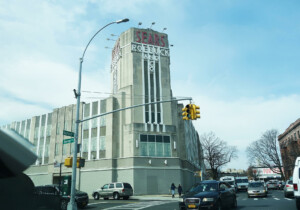In January, several cracks appeared on the exterior of the historic Los Angeles Times building in downtown L.A. While some have suggested the fissures may be due to ongoing transit construction next door, preservationists also say they could signal a larger problem—one that could threaten a controversial, mixed-use development on the site.
The Times Mirror Square project comprises the restoration of the L.A. Times’s flagship building, a 1935 structure by Gordon Kaufmann, as well as a 1948 addition by Rowland Crawford—both recently landmarked buildings—as well as the build-out of two apartments towers in place of what’s now a William L. Pereira–designed office structure from 1973. Vancouver-based developer Onni Group bought the five-building complex in 2016 and has since been through a fraught preservation battle to move the project forward. But now, the sight of cracks have people wondering what it will mean for the mega-project’s future.
“Who is responsible for this?” said preservationist Richard Schave, co-founder of historic L.A. tour company Esotouric, in reference to the cracks. “It’s the $64 million question.
That number refers to the cost of phase one construction on the Regional Connector project, L.A.’s massive rail line expansion. A new station is under construction next door to Times Mirror Square and the agency building it, the Metropolitan Transportation Authority (Metro), may be responsible. Metro is already monitoring the cracks of the L.A. Times buildings using geotechnical sensors. Details on the severity haven’t been released yet, but some think Metro may be forced to provide data for the final environmental impact report (EIR) of the Time Mirror Square project, which is due out in a few months.
Don Spivack, a former administrator at the L.A. Community Redevelopment Agency, said if the cracks on the structure are one to two millimeters, there’s nothing to worry about.
“They may be cosmetic, not structural cracks,” he said. “But this complex has a tangled history due to its layered construction. Each building was individually engineered and connected to the others in ways that permitted passage between them. If some of those connections were not properly engineered at the time or modified later, the question stands whether or not this poses a risk to their preservation.”
This isn’t the only issue. There’s a history of subsidence on buildings in the area when subways are built, and seismic activity has also likely caused them to move over the years, according to Spivak.
The L.A. Times reported that, so far, cracks have been noticed in the cafeteria, newsroom, and the Pereira-designed garage of the complex. Visible cracks on the facade can be seen on the first floor of the Crawford Building (a.k.a Mirror Tower), and on its northwest facade at the corner of 2nd and Spring Streets, across from Regional Connector construction.
While the idea that the building is sinking has sparked fear, Spivack and John Lorick, a former vice president at the L.A. Times, said it would be nearly impossible for that to be true. They also remarked on the overall neglect that Times Mirror Square had suffered under its last owner, Tribune Media. But, they said, any demolition and construction on or near the site could inevitably alter the historic structures—and Onni Group doesn’t have a great track record with that.
“I was not completely surprised when I first read about the damage to the [Kaufmann and Crawford] buildings,” said Lorick. “Although the reported damage was attributed to subway construction, I had always eventually expected to read about some accidental but irreparable damage to the Crawford and Kaufmann buildings during demolition or construction on the site because of the complex interconnection of the buildings and their foundations.”
When asked for comment, the developer didn’t respond by the time of publication. The L.A. Department of Building & Safety told AN that once the project goes through the entitlement process at City Planning, inspectors will investigate any structural issues brought to light.











